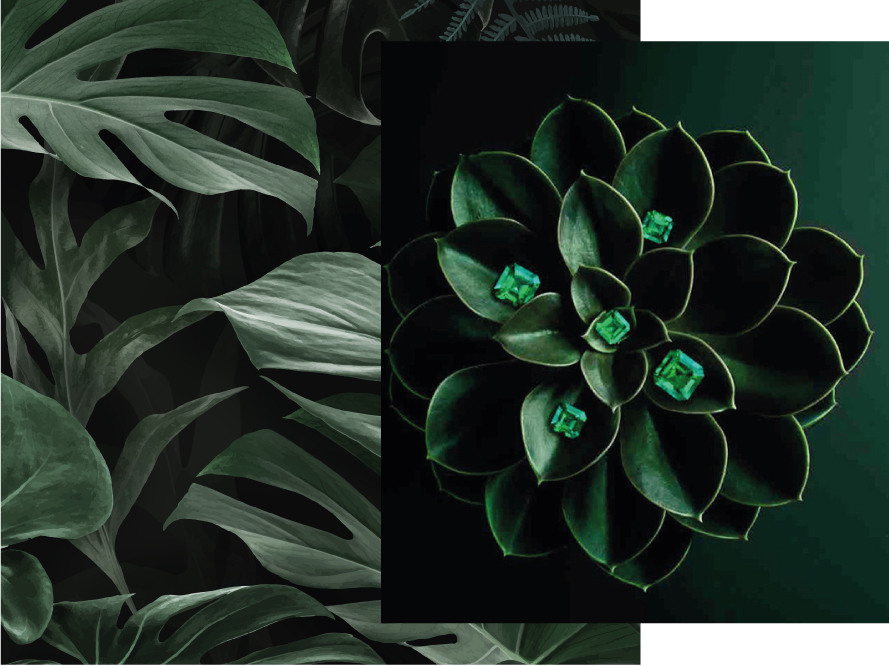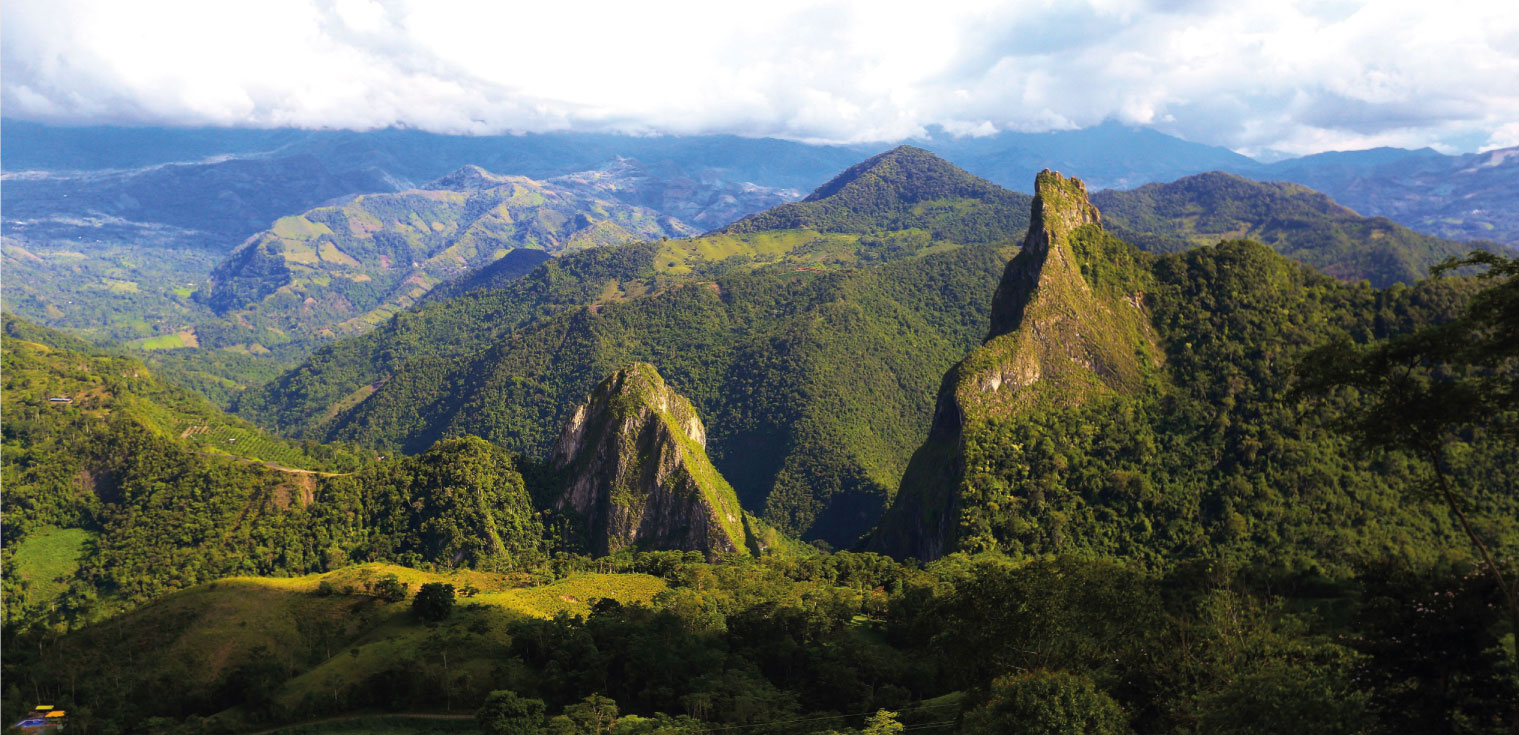

EMERALDS
When owning an Emerald you get to know its intricate details, patches, lines and unique internal glow, becoming your own personal work of art; a relationship rarely possible with other gemstones.
BEGINNERS GUIDE TO BUYING EMERALDS
WHAT TO KNOW BEFORE BUYING
4C’S OF EMERALDS
Knowing the physical attributes of a gemstone can help you make the right choice. The 4C’s which are used to evaluate a diamond can also be used to choose the right emerald. However, a different significance is assigned to each C when assessing emeralds. By using the information about the 4C’s of emeralds, you can find a gemstone for you.
COLOR
Traditionally emerald green should be the perfect balance of blue and yellow – a pure green hue. The appraisal and appreciation of colour is, of course, subjective to some extent. Emeralds from different origins often have distinctive colours although each deposit can have a range in hues.
- Color can be broken up into three categories :
Hue; The basic color.
Tone; The lightness or darkness.
Saturation; The strength or intensity of the hue.
CLARITY
A gemstone’s clarity has to do with the number of inclusions that it contains, the size of those inclusions and their position within the gemstone. The fewer, smaller and less conspicuous the inclusions, the better. It is, however, extremely unusual to find a “clean” emerald. Almost all contain imperfections, known as jardins (French for gardens), which are visible to the naked eye.
Unlike diamonds where the value diminishes when there are inclusions, emeralds contain them and are visible to the eye without the aid of any equipment. In fact, 99% of naturally occurring emeralds have inclusions. The GIA organizes emeralds as Type 3 which means that there are always inclusions. If you don’t see any inclusion, you need to check if the emerald is real or not.
Pro tip: 99% of emeralds are treated for clarity (one of the 4Cs). Emeralds are bought and sold on the premise they have been treated in some form.
At selva we specialize in No Oil, as well as Insignificant Oil and Minor Oil, which are ideal and minimal treatment when it comes to this precious stone.
CUT
Just like with diamonds, the emerald cutter, must consider the depth of color, durability and inclusions when making decisions about cutting the stone. Mistakes in cutting can seriously affect the value of this precious gem and can result in considerable weight loss.
Ideally, an emerald should be cut in a symmetrical manner so that the appropriate amount of light can pass through the stone. If cut too deeply, the light will escape on the side and the emerald will look dark. Similarly, if the cut is too shallow, the emerald will not appear brilliant. Since color is a very important consideration when choosing an emerald, the cut must maximize the hue, tone and saturation of the stone.
CARAT WEIGHT
Carat weight obviously helps determine the price of the emerald, and a 4 carat stone will be more expensive than a 1 carat stone, all other factors being equal. But carat weight plays a much larger role in the pricing of diamonds than it does with emeralds. With the latter, we are primarily interested in the color of the stone, then its clarity and cut, and only finally its carat weight.
HISTORY AND LEGENDS
While the first known records of Emerald mining are from the third century BC in Egypt. There is, however, some evidence of Emeralds dating as far back as 3500 BC. With many fascinating myths and mysterious stories about the gem. While cultures around the globe have embraced the lush green jewel, with tales of Cleopatra, to stories of treasures lost at sea. The Emerald has a rich history throughout Asia, Africa, Europe, as well as the New World.
The name emerald is a derivative of an ancient Persian word, coming to us through the corruption of the Latin `Smaragdus’. The history of the emerald is as fascinating as it is voluminous. The ancients prized it as the symbol of love, rebirth and eternal youth. Because the rich green color of emerald reminds of spring, it has been treasured for at least the past 4,000 years by different cultures all around the world.
Cleopatra reportedly valued her emeralds more than any other gem, and with good cause as the ancient Egyptians revered them as symbols of fertility and rebirth. The Romans believed that emeralds with a pale hue were immature and would grow to a deeper, richer colour with age. The ancient Roman scholar Pliny was so moved by the emerald’s lush colour he wrote, «nothing is more intense than the green of emerald» and «sight is refreshed and restored by gazing upon this stone». Following his advise, Roman emperor Nero wore emerald sunglasses to watch the gladiators.
Emerald is said to give a supernatural ability to foretell future events. A surprising variety of virtues have been ascribed to emerald. Among these, emerald was thought to improve its owner’s memory and eloquence, and was also said to quicken intelligence. In a particular instance of emerald’s use, as a measure against ills, women wearing the stone were believed to be immune from epilepsy.
This specific fable comes from the indigenous group called the Muzos. They inhabited what is today the Western part of the department of Boyacá, near the city of Muzo in Colombia, The region most famous for its beautiful emeralds. (follow @muzoemeralds for the most gorgeous emeralds from this region).
Fura and Tena, created by their god ‘Are’, were lovers staying forever young in the forest so long as they were faithful to one another. After many centuries living in peace and bliss, Fura fell in love with Zaribi, a man who came to her for help in seeeking a flower with magical powers. Because of her infidelity she began to age. When Tena saw her again, he immediately knew of the infidelity, and killed himself by her side. For days Fura wept green tears ... tears of Emeralds, leaving the land covered in these precious stones. When their god Are, came to visit, he saw what had happened and

Fura and Tena mountain Located in MUZO, Colombia.

